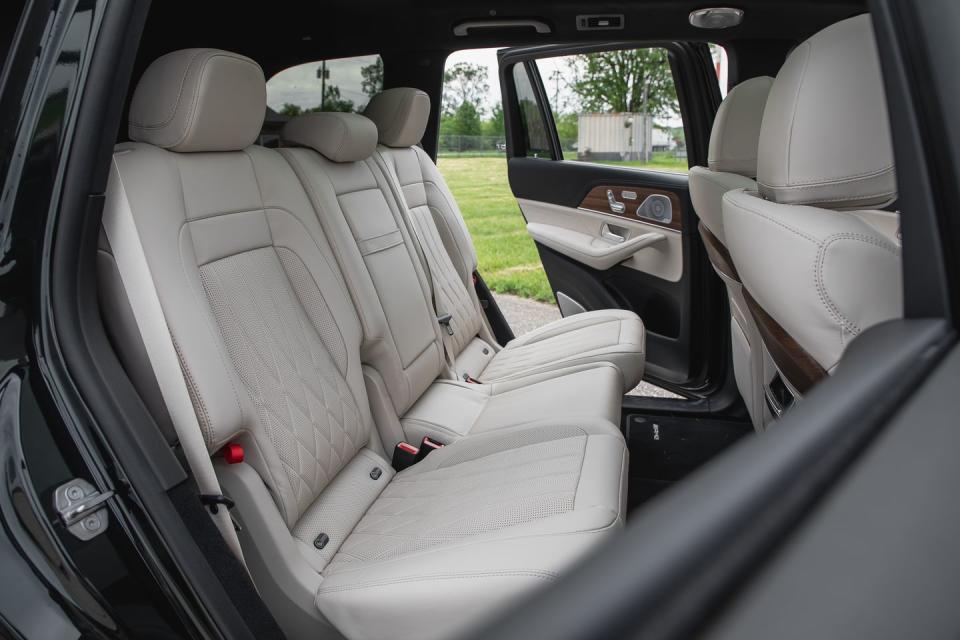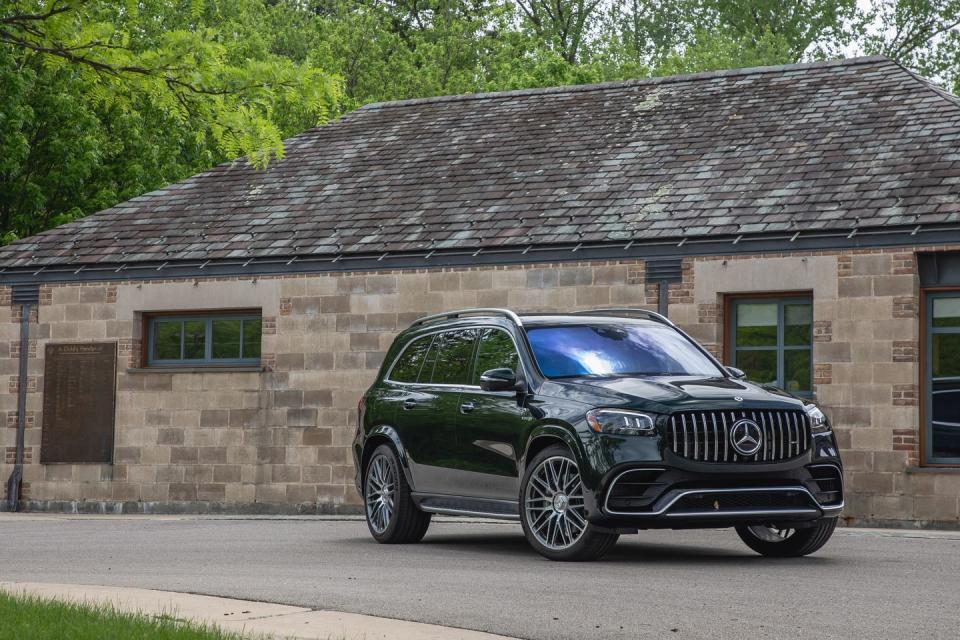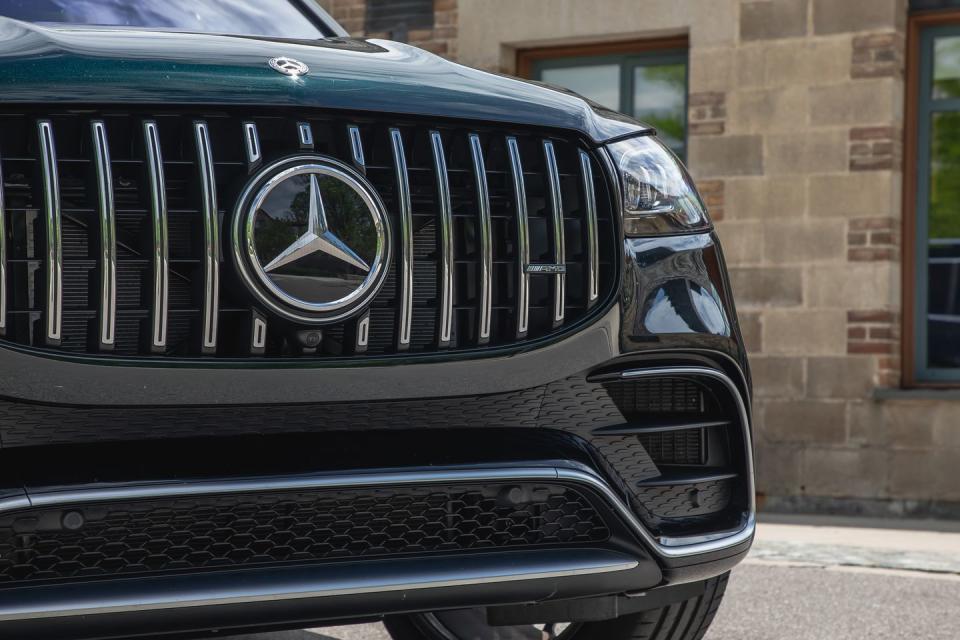Tested: 2021 Mercedes-AMG GLS63 Three-Row SUV Can Beat a C7 Corvette to 60

6/3/20 UPDATE: This review has been updated with test results.
Automakers are always looking for white space in the marketplace. Mercedes has gotten quite good at this over the years and has recently identified a previously unfilled gap that apparently needed addressing: Buyers looking for a proper six- or seven-passenger SUV with 600 horsepower and a six-figure sticker price had nowhere to go until the 2021 Mercedes-AMG GLS63 showed up.
Upon its imminent arrival at dealers this summer, the AMG version of the GLS-class will claim the title of the world's most powerful three-row luxury SUV. In doing so, it supplants the smaller and far more expensive Bentley Bentayga, which can be had with a 600-hp W-12 but is not a true competitor to the GLS. The Bentley's optional pair of small third-row jump seats manually fold out of its cargo floor and result in precious little cargo space in the way back—if you're able to convince passengers to occupy them. In contrast, every GLS63 comes with a relatively spacious, power-folding third row that affords 17 cubic feet of rear cargo room behind it. As we learned from driving the AMG both through the hills of Southern California and at our test track, however, there's more to the performance of this hulking SUV than its power rating.

Power to Spare
The GLS63 is almost mechanically identical to AMG's redesigned five-passenger GLE63 SUV. Both models share the same twin-turbo 4.0-liter V-8 that is hand-built in Germany and shipped to the Mercedes assembly plant in Tuscaloosa, Alabama. With its two turbos huffing up to 18.9 psi of boost, this engine produces 603 horsepower at 6500 rpm and 627 pound-feet of torque at 2500 rpm. That's 26 more horses and 66 pound-feet more than the twin-turbo 5.5-liter V-8 that powered the previous-generation GLS63.
But it must be making a lot more power than that. In our testing, the 5927-pound GLS63 shot to 60 mph in just 3.6 seconds on its way to a 12.0-second quarter-mile at 115 mph, which is almost a second quicker than the previous model. Not that we needed more evidence that we're living in insane times for power and performance, but those figures mean that this nearly three-ton behemoth can outrun a naturally aspirated C7 Chevrolet Corvette all the way through the quarter-mile. The GLS63 even nips at the heels of AMG's own GT sports car, which is only 0.2 second slower through the quarter.
As in the GLE, the 4.0-liter features AMG's first V-8 application of Mercedes's 48-volt EQ Boost hybrid system, which sandwiches an electric motor-generator between the engine and the standard nine-speed automatic transmission. The setup is mostly for powering the engine's electric accessories, including the water pump, power steering, and air-conditioning compressor. But it also can briefly apply its 21 horsepower and 184 pound-feet of torque to the powertrain to reduce lag from the engine and to theoretically improve its fuel economy.
It probably doesn't matter much to the GLS63's clientele, but our test vehicle's fuel economy in our 75-mph highway test was up a whopping 4 mpg to 22 mpg, a gain of more than 20 percent. That's likely thanks more to downsizing the engine from 5.5 to 4.0 liters more than the EQ Boost, though.

The V-8's torque peak spans from 2500 to 4500 rpm, which makes for plenty of low-down grunt before you get to its upper-rpm power. It pulls strongly all the way to its 7000-rpm redline, and the tight gear spacing of the automatic helps the big AMG accelerate with seamless verve. Each wide-open-throttle upshift delivers a strong kick to the driveline. Top speed is electronically limited to a Mercedes claimed 174 mph.
Although huge gains in both performance and fuel economy sound like a win-win formula, less displacement and more boost is a recipe for lag, and this latest GLS63 has gained plenty of it. Note that its 30-to-50-mph acceleration time is 0.3 second slower than before. (That's also partially due to the fact that the transmission is reluctant to kick down at that speed.). Also, the rolling-start 5-to-60-mph time is only a tenth of a second quicker. We often use the difference between the zero-to-60 and 5-to-60 times as a measure of lag. In the GLS63's case, that delta grew from 0.7 second in the previous-gen model to 1.2 seconds.

We also found the nine-speed transmission, which is responsive and snappy around town, to be a bit clumsy for spirited driving on twisty roads. It often upshifts when entering corners and is easy to catch out in too high a ratio. Toggling the transmission's manual mode and using the shift paddles on the back of the steering wheel helps in this regard. But gear changes still don't happen quickly enough. Ask for a downshift, and there's a beat before it arrives.
A Light-Footed Heavyweight
In Comfort mode, dynamic engine mounts stiffen automatically as you start to explore the GLS63's handling. This sharpens the vehicle's responses and enhances the feedback relayed to the driver. Selecting Sport or Sport+ also firms up the mounts, along with the SUV's standard air springs. Adaptive dampers stiffen 25 percent in Sport mode and another 40 percent in Sport+. There is no Race mode in the GLE63 S as there is in some harder-core AMG models. Ride quality is comfortable in every setting with the standard 21-inch or optional 22-inch wheels. Just know that, despite a wheelbase that's 8.6 inches longer than the GLE63 S, the GLS's ride won't be quite as plush as its smaller sibling's if you spring for one of its mondo 23-inch wheel options, which cost as much as $4950. And it's not just the large-wheel jitters; there's some odd undulations in its ride that can make it feel more discombobulated and aloof than before, which is possibly a side effect of trying to coax this vehicular elephant into dancing like a lighter beast.
Although it's bigger and heavier than the GLE63 S, the GLS63 actually feels better balanced. All-wheel drive and a limited-slip rear differential are standard, as is AMG's latest 48-volt Active Ride Control anti-roll system, which works well to manage body roll. This full-size SUV is surprisingly tossable on mountain roads, especially in its Sport and Sport+ modes, which lower the suspension 0.4 inch. The GLS63 sets up nicely in fast corners and offers plenty of front-end grip in tighter bends.

On the vehicles we've spent most of our time in, including our test car, the grip from the massive 23-inch Michelin Pilot Sport 4S summer tires—sized 285/40R-23 in front and 325/35R-23 in back—helped combat the big AMG's sense of mild understeer and let it circle the skidpad with 0.92 g of lateral grip. Although Mercedes offers carbon-ceramic brake rotors on the GLE63 S, they're not available on the GLS63. However, larger diameter wheels mean taller tire contact patches, which improve longitudinal grip. If that sounds too nerdy for you, try this: Our GLS63 stopped from 70 mph in a sports-car-like 153 feet. In fact, that distance is slightly better than what we recorded for the last AMG GT we tested, which is lighter than the GLS by some 2200 pounds, or nearly an entire Mazda Miata.
In all, there are six drive-mode settings. On the off chance anyone takes their GLS63 off road, it'll probably be in a gravel parking lot at an Eagles concert. But AMG added Trail and Sand modes anyway. Both increase ground clearance by raising the suspension 2.2 inches for a total of 9.7 inches.

Delivering the Goods
AMG has managed to dial up the muscularity of the GLS without overdoing it. There's a familiar AMG grille with vertical louvers, a new front bumper with mouthy black air intakes, flared wheel arches, a rear diffuser, and big rectangular exhaust outlets. Inside you'll find a chunky three-spoke steering wheel and standard heated, ventilated, and heavily bolstered AMG sports seats covered in nappa leather. Also included is in-dash navigation, a wireless phone charger, nine USB ports, a panoramic sunroof, heated second-row seats, and heated and cooled front cupholders. Second-row captain's chairs in place of the standard three-across bench seat are available, as are carbon-fiber trim, a head-up display, and heated third-row seats.
A test drive in the 2021 Mercedes-AMG GLS63 helps us understand why roughly half of the AMG models sold in the United States last year were SUVs. It has all of the refinement of the brand's big sedans and almost as much performance, yet with about an acre more interior space. Hot-rod utility vehicles may still make little rational sense. But it's no wonder that the segment continues to grow. While BMW has yet to indicate that it plans to build a more powerful variant of the three-row X7 beyond the current 523-hp M50i model, BMW tuner Alpina has plans to better the GLS63 with its upcoming 612-hp XB7. Dodge also appears to be working on a 707-hp Hellcat version of its Durango, which we figure should run with the GLS63 and cost about $50K less than the AMG's hefty $133,095 starting price.
That's the thing about white space. Once you fill it, you've essentially painted a bull's-eye on your back.
You Might Also Like

 Yahoo News
Yahoo News 
